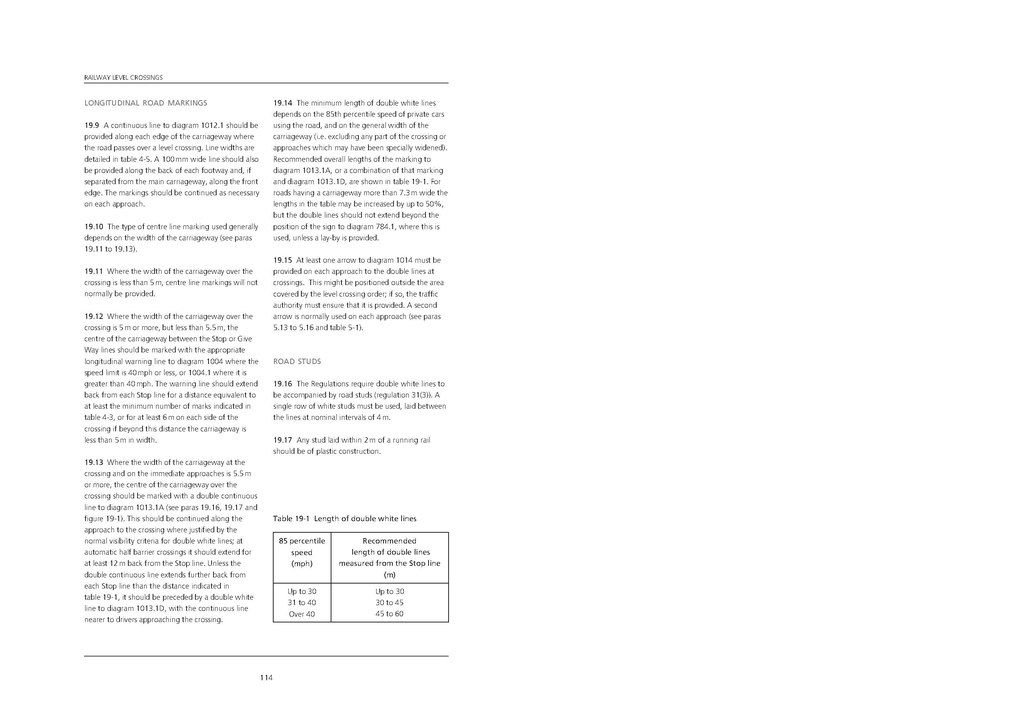LONGITUDINAL ROAD MARKINGS
19.9 A continuous line to diagram 1012.1 should be provided along each edge of the carriageway where the road passes over a level crossing. Line widths are detailed in table 4-5. A 100 mm wide line should also be provided along the back of each footway and, if separated from the main carriageway, along the front edge. The markings should be continued as necessary on each approach.
19.10 The type of centre line marking used generally depends on the width of the carriageway (see paras 19.11 to 19.13).
19.11 Where the width of the carriageway over the crossing is less than 5 m, centre line markings will not normally be provided.
19.12 Where the width of the carriageway over the crossing is 5 m or more, but less than 5.5 m, the centre of the carriageway between the Stop or Give Way lines should be marked with the appropriate longitudinal warning line to diagram 1004 where the speed limit is 40 mph or less, or 1004.1 where it is greater than 40 mph. The warning line should extend back from each Stop line for a distance equivalent to at least the minimum number of marks indicated in table 4-3, or for at least 6 m on each side of the crossing if beyond this distance the carriageway is less than 5 m in width.
19.13 Where the width of the carriageway at the crossing and on the immediate approaches is 5.5 m or more, the centre of the carriageway over the crossing should be marked with a double continuous line to diagram 1013.1A (see paras 19.16, 19.17 and figure 19-1). This should be continued along the approach to the crossing where justified by the normal visibility criteria for double white lines; at automatic half barrier crossings it should extend for at least 12 m back from the Stop line. Unless the double continuous line extends further back from each Stop line than the distance indicated in table 19-1, it should be preceded by a double white line to diagram 1013.1D, with the continuous line nearer to drivers approaching the crossing.
19.14 The minimum length of double white lines depends on the 85th percentile speed of private cars using the road, and on the general width of the carriageway (i.e. excluding any part of the crossing or approaches which may have been specially widened). Recommended overall lengths of the marking to diagram 1013.1A, or a combination of that marking and diagram 1013.1D, are shown in table [[[#table19.1|19-1]]. For roads having a carriageway more than 7.3 m wide the lengths in the table may be increased by up to 50%, but the double lines should not extend beyond the position of the sign to diagram 784.1, where this is used, unless a lay-by is provided.
19.15 At least one arrow to diagram 1014 must be provided on each approach to the double lines at crossings. This might be positioned outside the area covered by the level crossing order; if so, the traffic authority must ensure that it is provided. A second arrow is normally used on each approach (see paras 5.13 to 5.16 and table 5-1).
ROAD STUDS
19.16 The Regulations require double white lines to be accompanied by road studs (regulation 31(3)). A single row of white studs must be used, laid between the lines at nominal intervals of 4 m.
19.17 Any stud laid within 2 m of a running rail should be of plastic construction.
| 85 percentile speed (mph) |
Recommended length of double lines measured from the Stop line (m) |
|---|---|
| Up to 30 | Up to 30 |
| 31 to 40 | 30 to 45 |
| Over 40 | 45 to 60 |
114
